
Spånga Church is a church in the Spånga-Tensta borough in Stockholm, Sweden. It is part of Spånga-Kista Parish in the Diocese of Stockholm. The oldest part of the church originates from 1175–1200. Large reconstructions and enhancements took place during the 14th and 15th centuries.

Solna Church is a so-called round church in Solna Municipality near Stockholm, Sweden. It is part of Solna Parish in the Diocese of Stockholm. The church is located on the headland between Brunnsviken and Ulvsundasjön, at the southern end of the cemetery Norra begravningsplatsen. The oldest parts of the church are from the later 12th century, a Romanesque fortress church built in stone.

Garde Church is a medieval church in Garde on the Swedish island of Gotland. It was built in stages during the Middle Ages. The oldest part is the nave and the base of the tower, while the most recently constructed part is the large chancel. A large renovation was carried out in the 1960s. Garde Church together with its cemetery and its four lychgates constitute one of the most well-preserved medieval church ensembles in Sweden.

Lye Church is a medieval church on Gotland, Sweden. The oldest parts of the church date from the last quarter of the 12th century, and the last major addition was the disproportionately large chancel, built during the second quarter of the 14th century by a workshop known by its notname as Egypticus. The workshop was also responsible for constructing the largest of the church portals, which is also decorated with Gothic stone sculpture. The tower portal contains sculptures attributed to the Romanesque sculptor Sigraf. The church has been little altered since the end of the Middle Ages. Lye Church contains the largest preserved set of medieval stained glass windows in the Nordic countries, and its interior is also decorated by medieval wall paintings, uncovered in the 1950s. The altarpiece is from 1496, and the church also contains a triumphal cross from the same period.
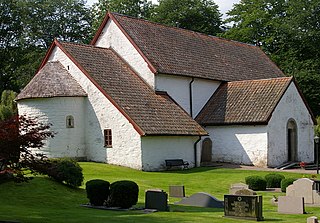
Gökhem Church is a medieval Lutheran church built in the Romanesque style. Located some 12 km (7.5 mi) west of Falköping in Västra Götaland County, Sweden, it belongs to the Diocese of Skara. One of Sweden's oldest stone churches, it is noted for its well-preserved 15th-century frescos, possibly the work of Master Amund.
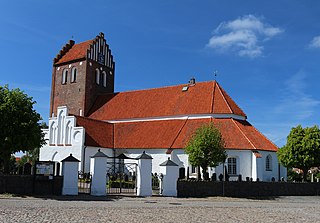
Båstad Church, also known as St. Mary's Church (Mariakyrkan), is a medieval Lutheran church built in the Romanesque style. Located in Båstad, seat of Skåne County in southern Sweden, it belongs to the Diocese of Lund.
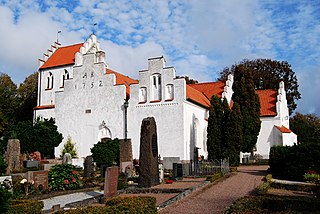
Brunnby Church is a medieval Lutheran church about 9 km (5.6 mi) north of Höganäs in southern Sweden. It belongs to the Diocese of Lund. The church is noted for its many 15th-century murals, attributed to the Helsingborg Workshop.

Fresta Church is a Lutheran church in the municipality of Upplands Väsby in Stockholm County, Sweden.

Gryta Church is a medieval Lutheran church located in a shallow valley about 2 kilometers northeast of Örsundsbro, in the Archdiocese of Uppsala in Uppsala County, Sweden. A few hundred meters west of the church is Salnecke Castle, one of Sweden's best-preserved castles from the mid-17th century.

Bäl Church is a medieval church in Gute, Bäl, on the Swedish island of Gotland. It was built during the first half of the 13th century and contains sculptural decoration in both Romanesque and Gothic styles. The interior is decorated by medieval wall paintings. It belongs to the parish of Väskinde, in the Diocese of Visby.

Hejnum Church is a medieval Lutheran church in Hejnum on the island of Gotland, Sweden. The church lies in the Diocese of Visby of the Church of Sweden.

Lokrume Church is a medieval church on the Swedish island of Gotland. The oldest parts of the church are from the 12th century. It belongs to the Diocese of Visby.
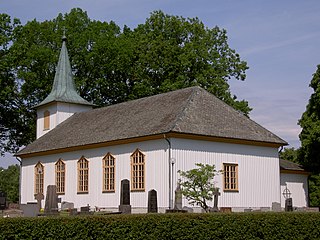
Tisselskog Church belongs to the Steneby-Tisselskogs parish in the Diocese of Karlstad, Sweden. The church is located on a hill about 2 km (1.2 mi) north of Lake Råvarpen, a part of the Dalsland Canal. Approximately 500 metres (1,600 ft) south of the church is a former clergy house, built in 1935. In the south part of the grave yard is a mourge built in the 1940s and a storage house built in 1995.

Vallstena Church is a medieval church on the island of Gotland, Sweden. It belongs to the Diocese of Visby.

Emmislöv Church is a church in Emmislöv, Östra Göinge Municipality, Sweden. It was built c. 1200 and contains several medieval murals.

Othem Church is a medieval church in Othem on Gotland, Sweden. It was built in the 13th century and contains several medieval murals.
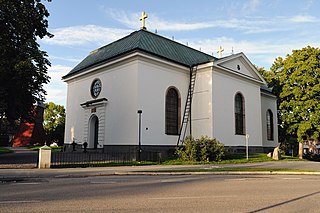
Vaxholm Church is a church in central Vaxholm, Sweden. The chapel is a single-nave building built in the Neoclassical style. It was completed in 1803 according to drawings by Carl Fredrik Adelcrantz and Olof Tempelman. It replaced an earlier wooden church in Vaxholm.
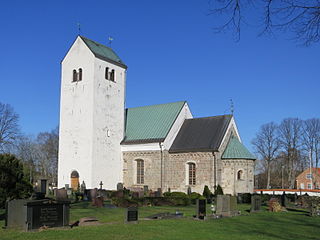
Vä Church, sometimes also called Saint Mary's Church in Vä is a well-preserved Romanesque church in Vä, in the southern Swedish province of Scania. It belongs to the Church of Sweden and is a listed building. It was built in the early 12th century, at a time when Scania was part of Denmark. The building was commissioned by a member of the Danish royal family, probably Queen Margaret Fredkulla. The church originally consisted of a nave, a chancel with an apse and two western towers. Quite soon after being finished, it was donated to Premonstratensian monks who used it as the church of their monastery until 1213. It simultaneously functioned as the parish church of Vä. At the end of the Middle Ages, a third tower was built, and in 1593 the building was enlarged. At the beginning of the 19th century, the western towers were demolished. A major restoration was carried out in the 1960s.
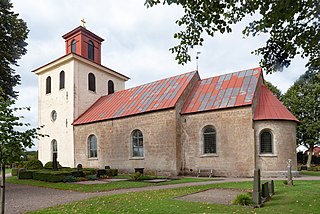
Norra Strö Church is a church in Norra Strö, a village in Kristianstad Municipality, Scania, Sweden. Built during the Middle Ages, it still contains medieval murals as well as a number of historical furnishings. The church was partially rebuilt during the 19th century and renovated in the 1940s. It belongs to the Church of Sweden.

Löderup Church is a medieval church in Löderup, Ystad Municipality, in the province of Skåne, Sweden. Dating from the 12th century, it has subsequently been expanded and rebuilt, not least under the guidance of architect Carl Georg Brunius in the 1860s. The church contains several old furnishings, including an unusual 12th-century baptismal font.





















